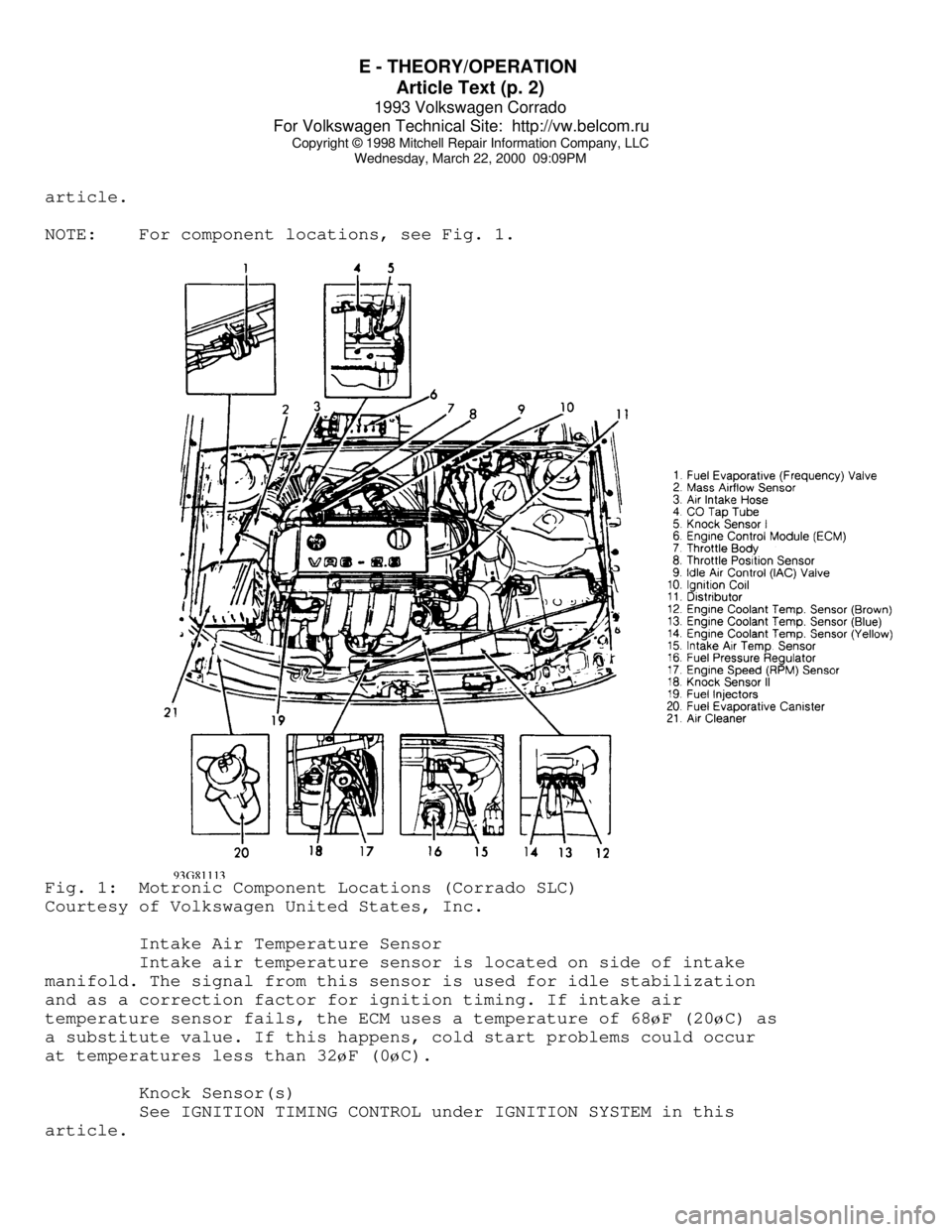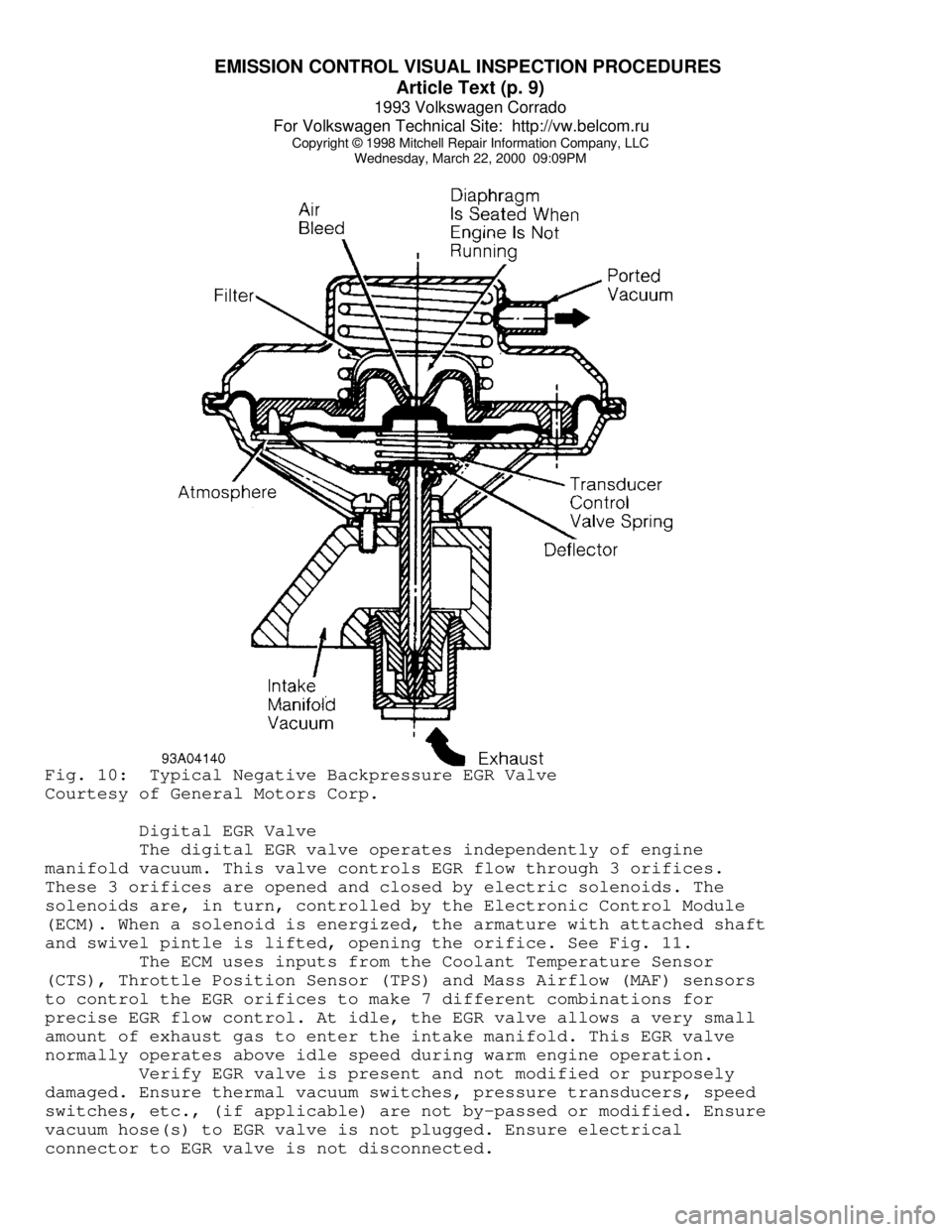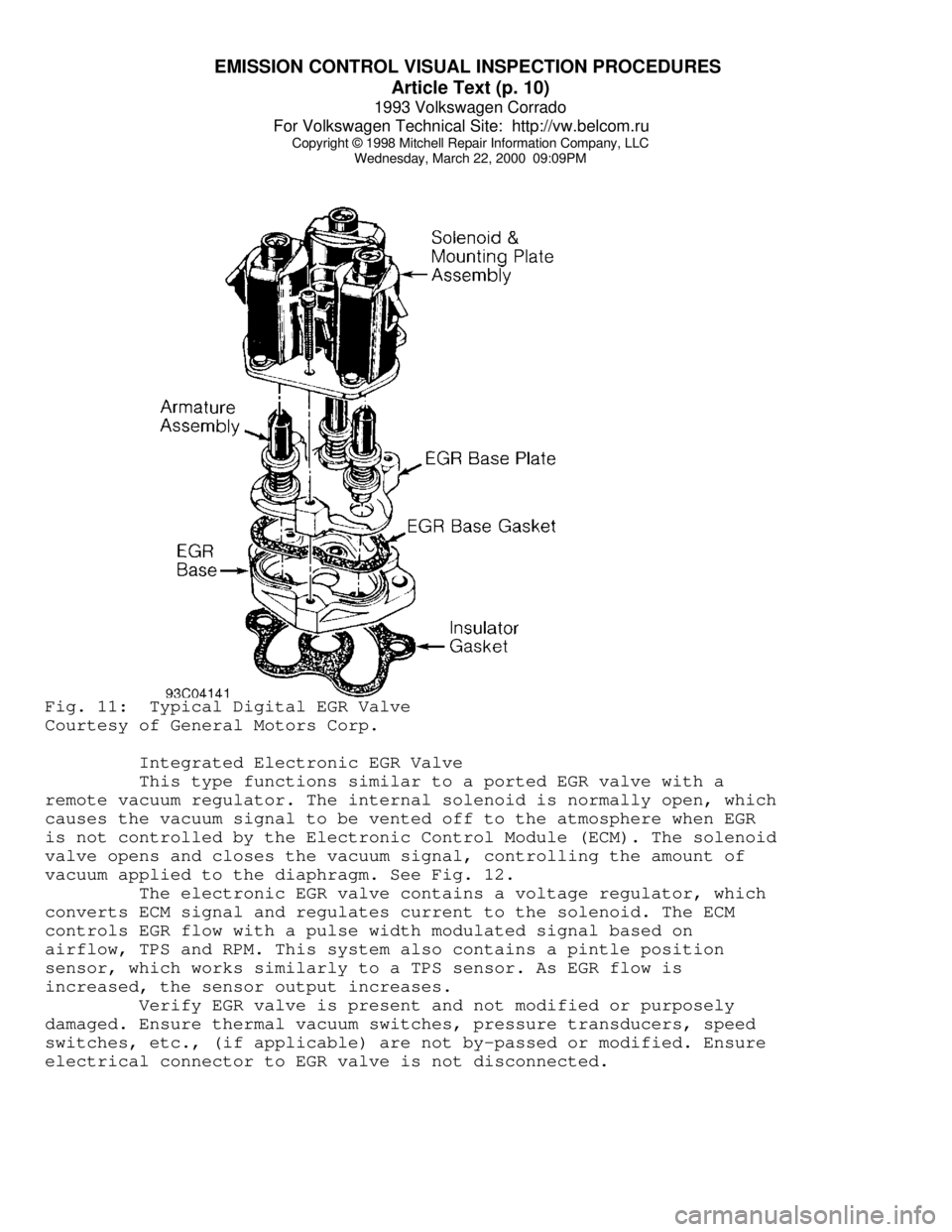1993 VOLKSWAGEN CORRADO sensor
[x] Cancel search: sensorPage 506 of 920

E - THEORY/OPERATION
Article Text
1993 Volkswagen Corrado
For Volkswagen Technical Site: http://vw.belcom.ru
Copyright © 1998 Mitchell Repair Information Company, LLC
Wednesday, March 22, 2000 09:09PM
ARTICLE BEGINNING
1993 ENGINE PERFORMANCE
Volkswagen Theory & Operation - Motronic
Corrado SLC
INTRODUCTION
This article covers basic description and operation of engine
performance-related systems and components. Read this article before
diagnosing vehicles or systems with which you are not completely
familiar.
COMPUTERIZED ENGINE CONTROLS
ELECTRONIC CONTROL UNIT
The Motronic engine management system uses a single
Electronic Control Module (ECM) for fuel injection, idle speed
control, ignition, and emission controls. The Electronic Control
Module (ECM) continually corrects air/fuel mixture based on signals
from various signals. The ECM is located underneath center of
windshield cowl, directly behind engine compartment firewall.
NOTE: Components are grouped into 2 categories. The first category
covers INPUT DEVICES, which control or produce voltage
signals monitored by the control unit. The second category
covers OUTPUT SIGNALS, which are components controlled by
the control unit.
INPUT DEVICES
Engine Coolant Temperature (ECT) Sensor
Sensor is located on thermostat housing. As engine coolant
temperature increases, the resistance of the sensor decreases. Engine
coolant temperature sensor signals are used for control of ignition
timing, injector pulse width, and idle speed stabilization. In
addition, knock sensors, idle speed control, oxygen sensor and fuel
tank venting are activated based on coolant temperature.
Engine Speed (RPM)/Reference Sensor
Engine speed (RPM) and crankshaft position are registered by
a single sensor located on side of engine block. The sensor reads a
toothed wheel mounted on the crankshaft. The wheel has a 2-tooth gap
which is used as a reference point for crankshaft position. The engine
speed/reference signal is used to monitor engine RPM and to identify
TDC position of cylinder No. 1.
Hall Effect Sensor
See ELECTRONIC IGNITION SYSTEM under IGNITION SYSTEM in this
Page 507 of 920

E - THEORY/OPERATION
Article Text (p. 2)
1993 Volkswagen Corrado
For Volkswagen Technical Site: http://vw.belcom.ru
Copyright © 1998 Mitchell Repair Information Company, LLC
Wednesday, March 22, 2000 09:09PM
article.
NOTE: For component locations, see Fig. 1.Fig. 1: Motronic Component Locations (Corrado SLC)
Courtesy of Volkswagen United States, Inc.
Intake Air Temperature Sensor
Intake air temperature sensor is located on side of intake
manifold. The signal from this sensor is used for idle stabilization
and as a correction factor for ignition timing. If intake air
temperature sensor fails, the ECM uses a temperature of 68øF (20øC) as
a substitute value. If this happens, cold start problems could occur
at temperatures less than 32
øF (0øC).
Knock Sensor(s)
See IGNITION TIMING CONTROL under IGNITION SYSTEM in this
article.
Page 508 of 920

E - THEORY/OPERATION
Article Text (p. 3)
1993 Volkswagen Corrado
For Volkswagen Technical Site: http://vw.belcom.ru
Copyright © 1998 Mitchell Repair Information Company, LLC
Wednesday, March 22, 2000 09:09PM
Mass Airflow Sensor
A hot-wire air mass sensor is used to measure airflow into
the engine. The sensor is attached to air filter housing. The hot-wire
in sensor is kept at 356øF (180øC) above air temperature.
As airflow increases, the wire is cooled and the resistance
of the sensor changes. The resulting current change is converted to a
voltage signal and is used by the ECM to calculate the volume of air
taken in.
If a fault develops with mass airflow sensor signal, the
signal from throttle valve potentiometer is used as a substitute in
order for the car to be driveable.
Throttle Valve Potentiometer
Throttle valve potentiometer (throttle position sensor) is
connected to throttle valve shaft. It informs the ECM about the power
requested by the driver (throttle opening). Idle and full throttle
switches are NOT used in potentiometer. Idle speed and full throttle
applications are recognized by the ECM from the voltage output of the
potentiometer.
Throttle valve potentiometer signals are used for idle speed
stabilization, idle air volume control, fuel after-run shut-off, and
full throttle enrichment. The ECM uses mass airflow sensor signal and
engine RPM signals as substitute values if the potentiometer fails.
NOTE: On automatic transmission equipped vehicles, the throttle
valve potentiometer is combined in the housing with the
potentiometer for transmission control.
Oxygen (O2) Sensor
The heated oxygen sensor is made from zirconium dioxide,
while the inner and outer surfaces are coated with platinum. If fuel
mixture is lean (excess oxygen), the oxygen sensor will send a low
voltage signal (about 100 millivolts) to the ECM. If fuel mixture is
rich (lack of oxygen), the oxygen sensor will send a high voltage
signal (about 900 millivolts) to the ECM.
OUTPUT SIGNALS
NOTE: Vehicles are equipped with different combinations of
computer-controlled components. Not all components listed
below are used on every vehicle. For theory and operation on
each output component, refer to the system indicated after
component.
EGR Frequency Valve
See EXHAUST GAS RECIRCULATION (EGR) SYSTEM under EMISSION
SYSTEMS in this article.
Fuel Evaporative (Frequency) Valve
See FUEL EVAPORATIVE EMISSIONS SYSTEM under EMISSION SYSTEMS
in this article.
Page 510 of 920

E - THEORY/OPERATION
Article Text (p. 5)
1993 Volkswagen Corrado
For Volkswagen Technical Site: http://vw.belcom.ru
Copyright © 1998 Mitchell Repair Information Company, LLC
Wednesday, March 22, 2000 09:09PM
NOTE: Corrado SLC models are equipped with a Distributorless
Ignition System (DIS).
ELECTRONIC IGNITION SYSTEM
The electronic ignition system consists of ECM, power output
stage, ignition coil, distributor, mass airflow sensor, throttle valve
potentiometer, engine coolant temperature sensor, and Hall Effect
sensor.
Ignition system uses engine speed, engine load, and throttle
valve potentiometer signals to calculate ignition timing. Engine
coolant temperature signal is used to correct ignition timing when
engine is cold and to activate knock sensor circuit. See KNOCK
SENSOR(S) under IGNITION TIMING CONTROL in this article.
Hall Effect Sensor
On Corrado SLC, this sensor is mounted on end of camshaft
(near ignition coil). Sensor consists of a magnetic enclosure and
integrated semi-conductor circuit. A voltage signal is generated when
trigger wheel, turning at camshaft speed, interrupts magnetic field
created by the semi-conductor. Hall Effect sensor and engine
speed/reference signals are used to identify TDC position of cylinder
No. 1 for sequential fuel injection and spark knock regulation.
DISTRIBUTORLESS IGNITION SYSTEM (DIS)
Hall Effect Sensor
See HALL EFFECT SENSOR under ELECTRONIC IGNITION SYSTEM in
this article.
Ignition Coil & Output Stage
The distributorless (direct) ignition system consists of ECM,
power output stage, 3 double-ended ignition coils and secondary
ignition wires. The ECM operates each ignition coil through the power
output stage. The power output stage and heat sink are located behind
ignition coils. The ignition coils are located on left side of
cylinder head. When the power output stage fires an ignition coil, a
spark is supplied to 2 spark plugs at one time. One spark plug fires
during the compression stroke, and the other spark plug fires during
the exhaust stroke (waste spark).
IGNITION TIMING CONTROL
Knock Sensor(s)
The knock sensor(s) work(s) like a microphone to "listen" for
spark knock (detonation). When detonation occurs, ignition timing is
retarded until the knock is eliminated.
On Corrado SLC, 2 knock sensors are mounted on side of engine
block. Knock sensor I monitors cylinders No. 1, 3 and 5. Knock sensor
II monitors cylinders No. 2, 4 and 6.
Page 511 of 920

E - THEORY/OPERATION
Article Text (p. 6)
1993 Volkswagen Corrado
For Volkswagen Technical Site: http://vw.belcom.ru
Copyright © 1998 Mitchell Repair Information Company, LLC
Wednesday, March 22, 2000 09:09PM
EMISSION SYSTEMS
AIR INJECTION SYSTEM
The air injection system consists of electrically operated
air pump, inlet valve, shut-off valve (mounted between intake ports
for cylinders No. 2 and 4), and air pump control relay.
The Electronic Control Module (ECM) control operation of air
injection system air pump by completing the ground circuit of the air
pump control relay (located above brake master cylinder). In addition,
the relay operates the secondary air injection inlet valve.
EXHAUST GAS RECIRCULATION (EGR) SYSTEM
The EGR system consist of EGR valve, EGR frequency valve, and
EGR temperature sensor. All Corrado SLC models are equipped with the
EGR system. The EGR system is switched on when engine coolant
temperature reaches 122øF (50øC). The system recirculates a small
portion of exhaust gas into the intake air/fuel mixture to reduce
nitrous oxide emissions (NOx).
EGR Frequency Valve
The EGR frequency valve is mounted on back of intake
manifold. The frequency valve controls the amount of vacuum supplied
to the EGR valve. The ECM, depending on engine speed and load,
controls the frequency valve's ground circuit. In doing so, the ECM
controls the amount of recirculated exhaust gas entering the engine.
EGR Temperature Sensor
Sensor is located in EGR valve exhaust gas recirculation
channel. The EGR temperature sensor measures exhaust gas temperature.
The electrical resistance of the sensor decreases as the temperature
of the exhaust gas increases. The signal generated by the EGR
temperature sensor is ONLY used for diagnosis of the EGR system.
FUEL EVAPORATIVE EMISSIONS SYSTEM
Fuel Evaporative (Frequency) Valve
The ECM determines the duty cycle of the frequency valve to
regulate the flow of fuel vapors from fuel evaporative (carbon)
canister into engine. When no current is supplied to valve, it remains
in the open position. The valve is closed (100% duty cycle) when the
engine is started cold. A spring operated check valve inside the
frequency valve closes when the engine is off. This prevents fuel
vapors from entering intake manifold and causing a rich mixture during
engine restart.
Fuel Tank Venting
The engine speed, engine load, engine coolant temperature,
and throttle valve potentiometer input signals are used by the ECM to
control fuel tank venting. Fuel vapors from fuel tank are vented to
fuel evaporative (carbon) canister. When engine is warm and above idle
Page 512 of 920

E - THEORY/OPERATION
Article Text (p. 7)
1993 Volkswagen Corrado
For Volkswagen Technical Site: http://vw.belcom.ru
Copyright © 1998 Mitchell Repair Information Company, LLC
Wednesday, March 22, 2000 09:09PM
speed, the vapors will be drawn into intake manifold. Depending on
engine load and oxygen sensor signal, the fuel evaporative (frequency)
valve will regulate the amount of vapors entering the intake manifold.
SELF-DIAGNOSTIC SYSTEM
The Electronic Control Module (ECM) recognizes faults (open
circuits, short circuits, missing signals, or a continuously applied
signal voltage) in the following circuits/components.
* EGR Frequency Valve
* EGR Temperature Sensor
* Engine Coolant Temperature Sensor
* Engine Speed (RPM)/Reference Sensor
* Fuel Evaporative (Frequency) Valve
* Hall Effect Sensor
* Idle Air Control/Stabilizer Valve
* Intake Air Temperature Sensor
* Knock Sensor(s)
* Throttle Valve Potentiometer
* Oxygen Sensor
MALFUNCTION INDICATOR (CHECK ENGINE) LIGHT
All California models are equipped with a malfunction
indicator (CHECK ENGINE) light. If CHECK ENGINE light comes on and
remains on during vehicle operation, cause of malfunction must be
determined. See the G - TESTS W/CODES article.
END OF ARTICLE
Page 523 of 920

EMISSION CONTROL VISUAL INSPECTION PROCEDURES
Article Text (p. 9)
1993 Volkswagen Corrado
For Volkswagen Technical Site: http://vw.belcom.ru
Copyright © 1998 Mitchell Repair Information Company, LLC
Wednesday, March 22, 2000 09:09PMFig. 10: Typical Negative Backpressure EGR Valve
Courtesy of General Motors Corp.
Digital EGR Valve
The digital EGR valve operates independently of engine
manifold vacuum. This valve controls EGR flow through 3 orifices.
These 3 orifices are opened and closed by electric solenoids. The
solenoids are, in turn, controlled by the Electronic Control Module
(ECM). When a solenoid is energized, the armature with attached shaft
and swivel pintle is lifted, opening the orifice. See Fig. 11.
The ECM uses inputs from the Coolant Temperature Sensor
(CTS), Throttle Position Sensor (TPS) and Mass Airflow (MAF) sensors
to control the EGR orifices to make 7 different combinations for
precise EGR flow control. At idle, the EGR valve allows a very small
amount of exhaust gas to enter the intake manifold. This EGR valve
normally operates above idle speed during warm engine operation.
Verify EGR valve is present and not modified or purposely
damaged. Ensure thermal vacuum switches, pressure transducers, speed
switches, etc., (if applicable) are not by-passed or modified. Ensure
vacuum hose(s) to EGR valve is not plugged. Ensure electrical
connector to EGR valve is not disconnected.
Page 524 of 920

EMISSION CONTROL VISUAL INSPECTION PROCEDURES
Article Text (p. 10)
1993 Volkswagen Corrado
For Volkswagen Technical Site: http://vw.belcom.ru
Copyright © 1998 Mitchell Repair Information Company, LLC
Wednesday, March 22, 2000 09:09PMFig. 11: Typical Digital EGR Valve
Courtesy of General Motors Corp.
Integrated Electronic EGR Valve
This type functions similar to a ported EGR valve with a
remote vacuum regulator. The internal solenoid is normally open, which
causes the vacuum signal to be vented off to the atmosphere when EGR
is not controlled by the Electronic Control Module (ECM). The solenoid
valve opens and closes the vacuum signal, controlling the amount of
vacuum applied to the diaphragm. See Fig. 12.
The electronic EGR valve contains a voltage regulator, which
converts ECM signal and regulates current to the solenoid. The ECM
controls EGR flow with a pulse width modulated signal based on
airflow, TPS and RPM. This system also contains a pintle position
sensor, which works similarly to a TPS sensor. As EGR flow is
increased, the sensor output increases.
Verify EGR valve is present and not modified or purposely
damaged. Ensure thermal vacuum switches, pressure transducers, speed
switches, etc., (if applicable) are not by-passed or modified. Ensure
electrical connector to EGR valve is not disconnected.